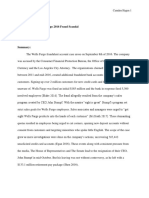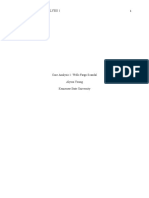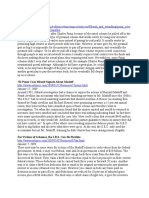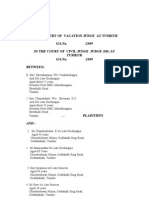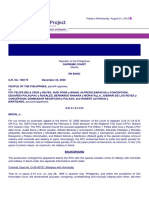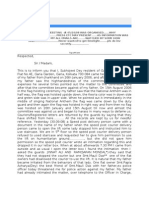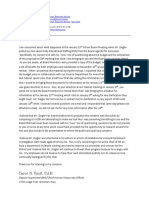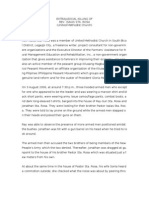Case Study - Fake Accounts
Case Study - Fake Accounts
Uploaded by
dhruva KumarCopyright:
Available Formats
Case Study - Fake Accounts
Case Study - Fake Accounts
Uploaded by
dhruva KumarOriginal Title
Copyright
Available Formats
Share this document
Did you find this document useful?
Is this content inappropriate?
Copyright:
Available Formats
Case Study - Fake Accounts
Case Study - Fake Accounts
Uploaded by
dhruva KumarCopyright:
Available Formats
Wells Fargo & Company is an American multinational, publicly traded financial services company that is
headquartered in San Francisco, California with main offices throughout the country. By this point in
time many citizens have become familiar with the scandal that has occurred at Wells Fargo Bank;
however, the astonishing part of this scandal is that the company has acted fraudulently and unethically.
Recent reports as of late 2017 demonstrated that Wells Fargo now says that it has found a total of up to
3.5 million potential fake bank accounts and credit card accounts which is 1.4 million more than
originally estimated. Additionally, approximately 190,000 accounts received unnecessary fees which is
60,000 more than originally estimated. The unethical behavior does not end here. It has been found that
528,000 customers were enrolled in unauthorized online bill pay, and up to 570,000 borrowers were
forced into unnecessary auto insurance; about 20,000 of these customers potentially had their cars
repossessed due to these insurance costs. The primary motive behind the millions of fake accounts can
be traced all the way up to the CEO and higher-level management. John Stumpf, former CEO of Wells
during the time, and senior executives put tremendous sales pressure on the employees of Wells Fargo
setting a target for the creation of eight accounts per customer. This tremendous sales pressure was
forced upon lower-level employees at Wells Fargo resulting in the creation of millions of fake accounts
which was done out of a fear that the average employee would lose his or her job if the demands of
management were not met.
There have been key governmental actions against Wells Fargo since the fake account scandal has taken
place. First, the company has been fined $185 million. Secondly, there has been a growth cap placed on
Wells. The bank has dealt with the currently faces investigations as well as class action lawsuits. These
are steps in the right direction to mitigate the effects of Wells Fargo's actions; however, they are not
enough. Individuals who hold the most responsibility including John Stumpf and senior management
who oversaw the fraud must be appropriately indicted. While the employees as Wells who carried out
the actions hold some level of responsibility, the ultimate responsibility must be targeted at Stumpf and
high-level management, those individuals who essentially forced the employees and coached them to
continually open fake accounts in the names of Wells Fargo customers. When the statistics pertaining to
profit is analysed, the unethicality associated with this case becomes even more gruelling. John Stumpf
and top-level management profited millions because of the surged stock price during the scandal of fake
accounts.
Do you think the current manager made the right decision?
Assume the same situation happened with xyz company.
If you are the manager of xyz, what would you have done differently?
You might also like
- Strategies Wells Fargo Can Use To GROW From A Billion Dollar Company To A Trillion Dollar CompanyDocument4 pagesStrategies Wells Fargo Can Use To GROW From A Billion Dollar Company To A Trillion Dollar CompanyEnock TareNo ratings yet
- The Rise and Fall of Phar-Mor Inc.Document14 pagesThe Rise and Fall of Phar-Mor Inc.Louis Lebron100% (1)
- Wells Fargo Fake AccountsDocument14 pagesWells Fargo Fake AccountsDrogNo ratings yet
- Fiftheditionfantasy Issue18 HorrorinblackwoodforestDocument32 pagesFiftheditionfantasy Issue18 HorrorinblackwoodforestRichard P White III50% (2)
- Millions of Fake Accounts That Drowning and Burying Wells FargoDocument67 pagesMillions of Fake Accounts That Drowning and Burying Wells Fargothe1uploader100% (1)
- Wells Fargo Case StudyDocument11 pagesWells Fargo Case StudyKatlene Hortilano100% (1)
- Wells Fargo Case Study Part 1Document11 pagesWells Fargo Case Study Part 1Joshua Lambert0% (1)
- Rogue Employees: How Your Most Prized Asset Can Be Your Worst LiabilityFrom EverandRogue Employees: How Your Most Prized Asset Can Be Your Worst LiabilityNo ratings yet
- Emergency Murder: WorksheetDocument2 pagesEmergency Murder: WorksheetIna CNo ratings yet
- Artifact 3 Gang PresentationDocument51 pagesArtifact 3 Gang Presentationapi-90932768100% (1)
- Grady v. Jefferson County, Colorado Et Al - Document No. 3Document4 pagesGrady v. Jefferson County, Colorado Et Al - Document No. 3Justia.comNo ratings yet
- Wells Fargo Account Fraud ScandalDocument5 pagesWells Fargo Account Fraud ScandalionverdesNo ratings yet
- Case Study 3Document4 pagesCase Study 3zama khanNo ratings yet
- Lanto, Danarose T - Case Study 5Document4 pagesLanto, Danarose T - Case Study 5Dana LantoNo ratings yet
- Management Information Systems-Assignment-1 Ethical Issues While Dealing With Information SystemsDocument2 pagesManagement Information Systems-Assignment-1 Ethical Issues While Dealing With Information SystemsRohit AroraNo ratings yet
- Wells Fargo Account Fraud Scandal - WikipediaDocument19 pagesWells Fargo Account Fraud Scandal - WikipediaChintuNo ratings yet
- Well Fargo 1Document4 pagesWell Fargo 1Lilian SooNo ratings yet
- Wells Fargo Customer Account FraudDocument8 pagesWells Fargo Customer Account Fraudsohel alamNo ratings yet
- MPRA - Paper - 93726 Wells FargoDocument30 pagesMPRA - Paper - 93726 Wells Fargomichaelasobrevega03No ratings yet
- Wells Fargo Scandal: Compiled and Presented By: M.Hashim, Muneeb Tariq, Hamza Arif and Sher KhanDocument24 pagesWells Fargo Scandal: Compiled and Presented By: M.Hashim, Muneeb Tariq, Hamza Arif and Sher KhanHashim MalikNo ratings yet
- Times Report FinalDocument5 pagesTimes Report Finalapi-401208815No ratings yet
- Wells Fargo Scandal-1Document15 pagesWells Fargo Scandal-1kunalsinghalco21b1009No ratings yet
- All Was Not Well Wells FargoDocument20 pagesAll Was Not Well Wells FargoNahom G KassayeNo ratings yet
- PRMIA - Wells Fargo - 110321Document10 pagesPRMIA - Wells Fargo - 110321azizNo ratings yet
- A Compilation of Individual Report: S.Y. 2018 - 2019 1 SemesterDocument6 pagesA Compilation of Individual Report: S.Y. 2018 - 2019 1 SemesterHardworkNo ratings yet
- BSS056-3 SEM1 AS2 Wells Fargo Case Study (1)Document10 pagesBSS056-3 SEM1 AS2 Wells Fargo Case Study (1)sirkaleshNo ratings yet
- Bai tap KTTC 3Document15 pagesBai tap KTTC 3Duc NguyenNo ratings yet
- wells fargo summaryDocument6 pageswells fargo summaryGayathri SantoshNo ratings yet
- Polonsky Vs WellsDocument32 pagesPolonsky Vs WellsZerohedgeNo ratings yet
- Wells Fargo Ethical IssuesDocument11 pagesWells Fargo Ethical IssuesLilian SooNo ratings yet
- Case Study 3 Team 4 BSA 32Document7 pagesCase Study 3 Team 4 BSA 32jajajaredredNo ratings yet
- 2015-16 Accounting Scandals Wells Fargo Fake Accounts Scandal CaseDocument5 pages2015-16 Accounting Scandals Wells Fargo Fake Accounts Scandal CaseRidhima KalraNo ratings yet
- Case Study BPMDocument14 pagesCase Study BPMBeshoy SafwatNo ratings yet
- Recognizing First Party FraudDocument6 pagesRecognizing First Party FraudNirmal ShahNo ratings yet
- American Insurance Group ScandalDocument3 pagesAmerican Insurance Group ScandalMartin Stojanovic75% (4)
- Accounting Fraud and Forensic Investigation: An IntroductionDocument19 pagesAccounting Fraud and Forensic Investigation: An IntroductionLO WANYEENo ratings yet
- Gf&Co Executive Summary: JPM - Out of ControlDocument5 pagesGf&Co Executive Summary: JPM - Out of Controldavid_dayen3823No ratings yet
- Carrie Tolstedt Discussion With SolutionsDocument9 pagesCarrie Tolstedt Discussion With SolutionsKrîzèllê B. MëndòzâNo ratings yet
- Wells Fargo BankDocument14 pagesWells Fargo Bankvian hassanNo ratings yet
- U.S. Attorney District of NJ Press Release: 18 Charged in International $200 Million Credit Card Fraud ScamDocument5 pagesU.S. Attorney District of NJ Press Release: 18 Charged in International $200 Million Credit Card Fraud ScamThe Jersey City IndependentNo ratings yet
- Case Analysis 1 - Wells Fargo ScandalDocument9 pagesCase Analysis 1 - Wells Fargo Scandalapi-387665617100% (3)
- GJBP Vol 2 No 1 2018-pgs-124-133Document10 pagesGJBP Vol 2 No 1 2018-pgs-124-133siddhi66421No ratings yet
- AMER Investigation Request - DOJDocument7 pagesAMER Investigation Request - DOJgustavo.kahilNo ratings yet
- Wells Fargo-A Case-Study On Corporate GovernanceDocument4 pagesWells Fargo-A Case-Study On Corporate GovernanceRuiz, CherryjaneNo ratings yet
- Mes/index - Html?inline Nyt-Classifier: #1 Ponzi SchemesDocument5 pagesMes/index - Html?inline Nyt-Classifier: #1 Ponzi SchemesAdatu JuNo ratings yet
- Case 12Document5 pagesCase 12dickrast5No ratings yet
- Fraud-Health South CaseDocument4 pagesFraud-Health South CaseKenneth WongNo ratings yet
- Wells Fargo's Unauthorized Customer AccountsDocument3 pagesWells Fargo's Unauthorized Customer AccountsSammy Chege100% (1)
- Old Trick, New Victims - The Rise of Money Mules During The PandemicDocument4 pagesOld Trick, New Victims - The Rise of Money Mules During The PandemicRezaul KarimNo ratings yet
- Wells Fargo Banking ScandalDocument3 pagesWells Fargo Banking ScandalGulzhan AmanbaikyzyNo ratings yet
- Unethical Business Practices 5Document4 pagesUnethical Business Practices 5Mageto EzraNo ratings yet
- Accountants Are Viewed As VilliansDocument1 pageAccountants Are Viewed As VilliansEkta KushwahaNo ratings yet
- Singson Reaction PaperDocument2 pagesSingson Reaction PaperDonna Mae SingsonNo ratings yet
- Fraud 101: Techniques and Strategies for Understanding FraudFrom EverandFraud 101: Techniques and Strategies for Understanding FraudNo ratings yet
- Corporate GovernanceDocument11 pagesCorporate GovernanceUtkarsh SrivastavaNo ratings yet
- Files WellsFargoCaseStudy EthSystems May2018FINALDocument28 pagesFiles WellsFargoCaseStudy EthSystems May2018FINALRawat SeemaNo ratings yet
- Evidence of Intent To Commit An Actual Fraud MF GlobalDocument19 pagesEvidence of Intent To Commit An Actual Fraud MF GlobalInvestor ProtectionNo ratings yet
- Five Lessons of The WorldCom DebacleDocument3 pagesFive Lessons of The WorldCom DebacleFolke ClaudioNo ratings yet
- Fraud in The PhilippinesDocument2 pagesFraud in The PhilippinesJessa Caberte100% (1)
- Wells Fargo Where Did They Go Wrong by James Venable PDF 02Document7 pagesWells Fargo Where Did They Go Wrong by James Venable PDF 02tombinhminh2003No ratings yet
- Fin STM Fraud 2Document6 pagesFin STM Fraud 2Okwuchi AlaukwuNo ratings yet
- Summary of These Are the Plunderers by Gretchen Morgenson: How Private Equity Runs—and Wrecks—AmericaFrom EverandSummary of These Are the Plunderers by Gretchen Morgenson: How Private Equity Runs—and Wrecks—AmericaNo ratings yet
- Medical Jurisprudence GuideDocument13 pagesMedical Jurisprudence GuideSev SevaarNo ratings yet
- Partition Suit in Vacation CourtDocument22 pagesPartition Suit in Vacation CourtSridhara babu. N - ಶ್ರೀಧರ ಬಾಬು. ಎನ್93% (27)
- Letter of Instructions No. 621Document6 pagesLetter of Instructions No. 621Darwin R. FabianNo ratings yet
- Ajeet Singh ProfileDocument4 pagesAjeet Singh ProfileSarahWraight100% (1)
- PP Vs DELA CRUZDocument21 pagesPP Vs DELA CRUZAnonymous 96BXHnSziNo ratings yet
- No. 46 Mondragon vs. People GR. No. G.R. No. L 17666Document2 pagesNo. 46 Mondragon vs. People GR. No. G.R. No. L 17666Johnson YaplinNo ratings yet
- Do These Meeeting DT 05/10/08 Was Organised...... Why Not........ Fear..... As........ Press Etc MayDocument17 pagesDo These Meeeting DT 05/10/08 Was Organised...... Why Not........ Fear..... As........ Press Etc MayCommonManThe SuffererNo ratings yet
- Letter From Dr. Tolx To Superintendent BlackburnDocument2 pagesLetter From Dr. Tolx To Superintendent BlackburnAnonymous vkQAcoRTNo ratings yet
- FInal Project WorkingDocument24 pagesFInal Project WorkingSuhas PawarNo ratings yet
- Thesis Essay On Gun ControlDocument4 pagesThesis Essay On Gun Controlf5da9eqt100% (2)
- Script of Hansal Mehta's ShahidDocument137 pagesScript of Hansal Mehta's Shahidmoifightclub92% (13)
- Pastor Isaias Sta. RosaDocument4 pagesPastor Isaias Sta. RosapunongbathalaNo ratings yet
- Plagiarism: Giving Credit Where Credit Is Due!Document29 pagesPlagiarism: Giving Credit Where Credit Is Due!Wnz NaiveNo ratings yet
- RAPE Complaint AffidavitDocument6 pagesRAPE Complaint AffidavitReynaldo Fajardo YuNo ratings yet
- How Has Violence Affected My Life?Document1 pageHow Has Violence Affected My Life?Humberto CNo ratings yet
- Case DigestDocument20 pagesCase DigestKelly MatiraNo ratings yet
- Circumstances Affecting Criminal LiabilityDocument13 pagesCircumstances Affecting Criminal LiabilityJayzyl PongautanNo ratings yet
- Chapter Iv - Right To Privacy Disini Vs Secretary of Justice GR No. 203335, February 11, 2014Document9 pagesChapter Iv - Right To Privacy Disini Vs Secretary of Justice GR No. 203335, February 11, 2014Vanessa Evans CruzNo ratings yet
- Harboring and Target IdentificationDocument8 pagesHarboring and Target IdentificationNosliw NonayatnabNo ratings yet
- 2012-11 Arresting Corruption in The PoliceDocument86 pages2012-11 Arresting Corruption in The PolicePatricia PiroloNo ratings yet
- The Hidden History of The Incredibly Evil Khazarian MafiaDocument20 pagesThe Hidden History of The Incredibly Evil Khazarian MafiaQuiztronNo ratings yet
- Self DefenceDocument16 pagesSelf DefenceBarr A. A KolawoleNo ratings yet
- Complaint Affidavit LibelDocument9 pagesComplaint Affidavit LibelIan Dominic LigasonNo ratings yet
- Quiz - Docx On Crime Prevention 20 Items W-Answer KeyDocument3 pagesQuiz - Docx On Crime Prevention 20 Items W-Answer KeymicrosoftcredintialsNo ratings yet
- Gonzales Cannon April 5 IssueDocument34 pagesGonzales Cannon April 5 IssueGonzales CannonNo ratings yet
- Seminar 7 CausationDocument23 pagesSeminar 7 CausationAzizul KirosakiNo ratings yet





